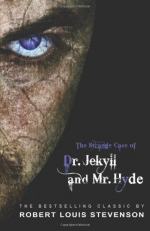|
This section contains 268 words (approx. 1 page at 300 words per page) |
The phrase "Dr. Jekyll and Mr. Hyde" is a popular metaphor to express the dual nature of human beings, who are capable of such great goodness and almost unbelievable evil. It is derived from the respectable Victorian doctor with a demonic alter ego who first appeared in the eponymous novella (1886) by Scottish writer Robert Louis Stevenson (1850-94). The tragedy of the scientist who finds the formula to isolate his evil side but fails to control it has been frequently transferred to the screen. The story was first filmed in 1908, and versions range from Robert Mamoulian's 1931 film, with Academy Award-winner Fredric March in the title role, to Stephen Frears' irregular Mary Reilly (1995). However, the presence of Jekyll and Hyde can be detected in many other films, novels, and comics of the last one hundred years only remotely inspired by Stevenson. Stories dealing with scientists involved in fatal accidents, tormented serial killers, and even secret superheroes are ultimately indebted to Stevenson's Gothic masterpiece.
Further Reading:
Frayling, Christopher. Nightmare: The Birth of Horror. London, BBC Books, 1996, 114-61.
Geduld, Harry M. The Definitive Dr. Jekyll and Mr. Hyde Companion. New York, Garland, 1983.
King, Charles. "Dr. Jekyll and Mr. Hyde: A Filmography." The Journal of Popular Film and Television. Vol. 25, No. 1, 1997, 9-20.
Rose, Brian A. Jekyll and Hyde Adapted: Dramatizations of Cultural Anxiety. Contributions in Drama and Theatre Studies 66. London, Greenwood, 1996.
Skal, David. The Monster Show: A Cultural History of Horror. London, Plexus, 1993.
Veeder, William, and Gordon Hirsch, editors. Dr. Jekyll and Mr. Hyde after One Hundred Years. Chicago, University of Chicago Press, 1988.
|
This section contains 268 words (approx. 1 page at 300 words per page) |


